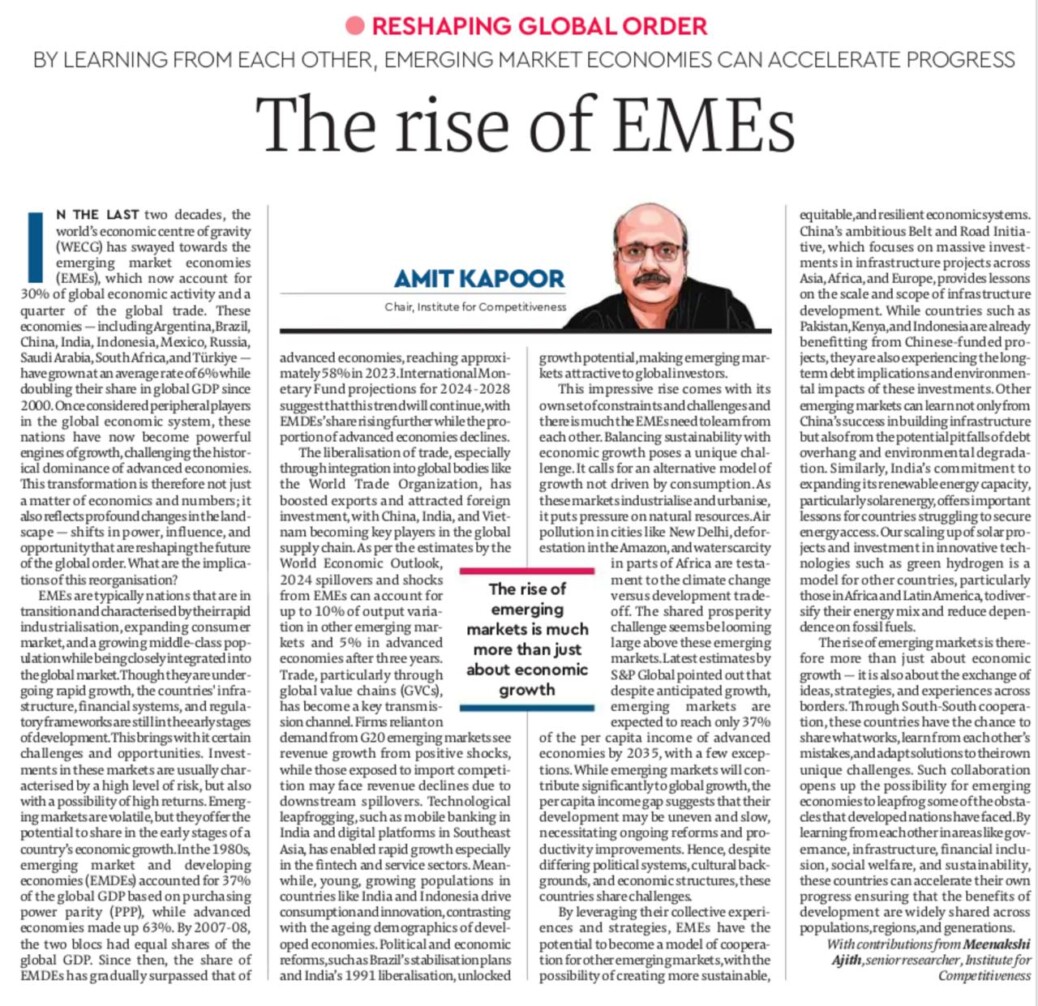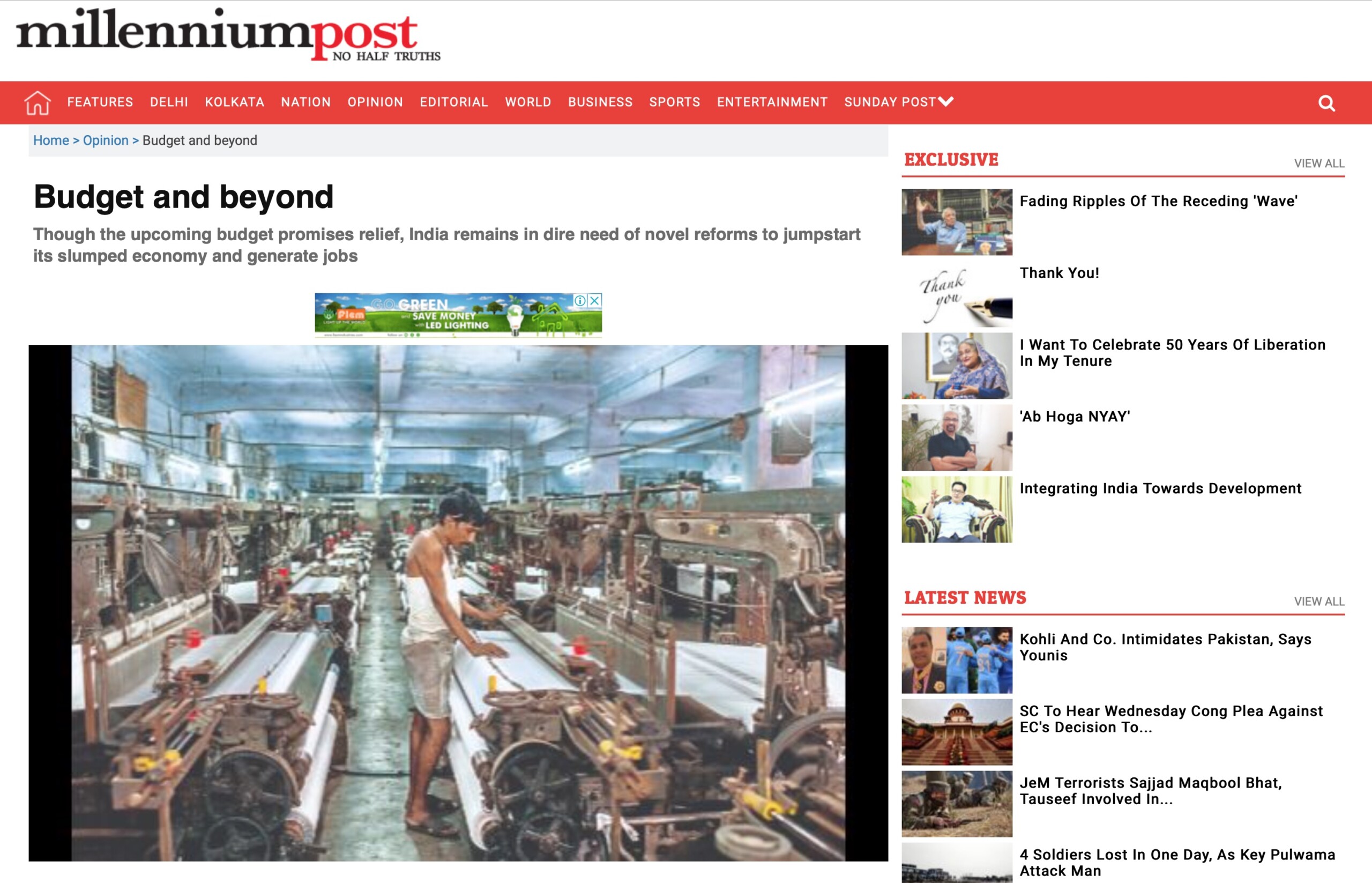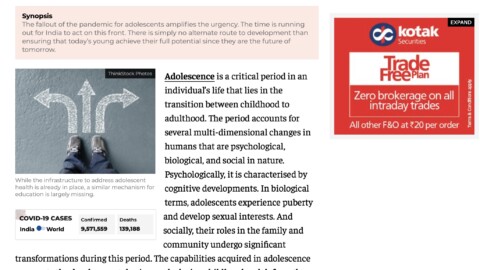The emergence of Emerging Market Economies
In the last two decades, the world’s economic centre of gravity (WECG) has swayed towards the Emerging Markets, which now account for 30% of global economic activity and a quarter of the global trade. These economies including Argentina, Brazil, China, India, Indonesia, Mexico, Russia, Saudi Arabia, South Africa, and Türkiye have grown at an average rate of 6% while doubling their share in Global GDP since 2000. Once considered peripheral players in the global economic system, these nations have now become powerful engines of growth, challenging the historical dominance of advanced economies. This transformation is therefore not just a matter of economics and numbers; it also reflects profound changes in the global landscape—shifts in power, influence, and opportunity that are reshaping the future of the global order. What are the implications of this global reorganization?
EME’s are typically nations that are in transition and characterized by their rapid industrialization, expanding consumer market and a growing middle-class population while being closely integrated into the global market. Though they are undergoing rapid growth, the country’s’ infrastructure, financial systems, and regulatory frameworks are still in the early stages of development. Now this brings with it certain challenges and opportunities. Investments in these markets are usually characterized by a high level of risk but with a possibility of high returns. Emerging markets are volatile, but they offer the potential to share in the early stages of a country’s economic growth. In the 1980s, Emerging Market and Developing Economies (EMDEs) accounted for 37% of global GDP based on purchasing power parity (PPP), while Advanced Economies made up 63%. By 2007-08, the two blocs had equal shares of the global GDP. Since then, the share of EMDEs has gradually surpassed that of advanced economies, reaching approximately 58% in 2023. IMF projections for 2024-2028 suggest that this trend will continue, with EMDEs’ share rising further while the proportion of advanced economies declines.
The liberalization of trade, especially through integration into global bodies like the WTO, has boosted exports and attracted foreign investment, with China, India, and Vietnam becoming key players in the global supply chain. As per the estimates by the World Economic Outlook, 2024 spillovers and shocks from EMEs can account for up to 10% of output variation in other emerging markets and 5% in advanced economies after three years. Trade, particularly through global value chains (GVCs), has become a key transmission channel. Firms reliant on demand from G20 emerging markets see revenue growth from positive shocks, while those exposed to import competition may face revenue declines due to downstream spillovers. Technological leapfrogging, such as mobile banking in India and digital platforms in Southeast Asia, has enabled rapid growth especially in fintech and service sectors. Meanwhile, young, growing populations in countries like India, and Indonesia drive consumption and innovation, contrasting with the aging demographics of developed economies. Political and economic reforms, such as Brazil’s stabilization plans and India’s 1991 liberalization, further unlocked growth potential, making emerging markets increasingly attractive to global investors.
This impressive rise however comes with its own set of constraints and challenges and there is much the EME’s need to learn from each other. Balancing sustainability with economic growth poses a one-of-a-kind challenge. It calls for an alternate model of growth not driven by consumption. As these markets industrialize and urbanize, it puts immense pressure on natural resources. Air pollution in cities like New Delhi, deforestation in the Amazon, and water scarcity in parts of Africa are testament to the climate change Vs development trade-off. The shared prosperity challenge seems be looming large above these emerging markets. Latest estimates by S&P Global pointed that despite anticipated growth, emerging markets are expected to reach only 37% of the per capita income of advanced economies by 2035, with a few exceptions. While emerging markets will contribute significantly to global growth, the per capita income gap suggests that their development may be uneven and slow, necessitating ongoing reforms and productivity improvements. Hence, despite differing political systems, cultural backgrounds, and economic structures these countries share several common challenges.
By leveraging their collective experiences and strategies, EMEs have the potential to become a model of cooperation for other emerging markets, with the possibility of creating more sustainable, equitable, and resilient economic systems.China’s ambitious Belt and Road Initiative, which focuses on massive investments in infrastructure projects across Asia, Africa, and Europe, provides lessons on the scale and scope of infrastructure development. While countries such as Pakistan, Kenya, and Indonesia are already benefiting from Chinese-funded projects, they are also experiencing the long-term debt implications and environmental impacts of these investments. Other emerging markets can learn not only from China’s success in building infrastructure but also from the potential pitfalls of debt overhang and environmental degradation. Similarly, India’s commitment to expanding its renewable energy capacity, particularly solar energy, offers important lessons for countries struggling to secure energy access. Our scaling up of solar projects and investment in innovative technologies such as green hydrogen is a model for other countries, particularly those in Africa and Latin America, to diversify their energy mix and reduce dependence on fossil fuels.
The rise of emerging markets is therefore more than just about economic growth, it’s also about the exchange of ideas, strategies, and experiences across borders. Through South-South cooperation, these countries have the chance to share what works, learn from each other’s mistakes, and adapt solutions to their own unique challenges. This kind of collaboration opens up the possibility for emerging economies to leapfrog some of the obstacles that more developed nations have faced. By learning from each other’s successes and failures in areas like governance, infrastructure development, financial inclusion, social welfare, and sustainability, these countries can accelerate their own progress ensuring that the benefits of development are widely shared across populations, regions, and generations.
The article was published with Financial Express on November 15, 2024.
























